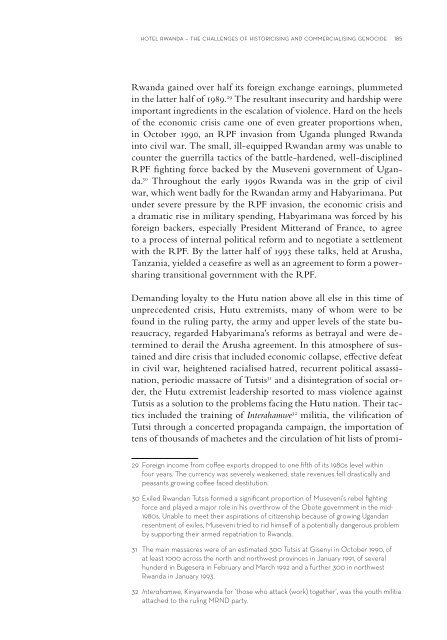60 years after the UN Convention - Dag Hammarskjöld Foundation
60 years after the UN Convention - Dag Hammarskjöld Foundation
60 years after the UN Convention - Dag Hammarskjöld Foundation
You also want an ePaper? Increase the reach of your titles
YUMPU automatically turns print PDFs into web optimized ePapers that Google loves.
hotel rwanda – <strong>the</strong> challenges of historicising and commercialising genocide 185<br />
Rwanda gained over half its foreign exchange earnings, plummeted<br />
in <strong>the</strong> latter half of 1989. 29 The resultant insecurity and hardship were<br />
important ingredients in <strong>the</strong> escalation of violence. Hard on <strong>the</strong> heels<br />
of <strong>the</strong> economic crisis came one of even greater proportions when,<br />
in October 1990, an RPF invasion from Uganda plunged Rwanda<br />
into civil war. The small, ill-equipped Rwandan army was unable to<br />
counter <strong>the</strong> guerrilla tactics of <strong>the</strong> battle-hardened, well-disciplined<br />
RPF fi ghting force backed by <strong>the</strong> Museveni government of Uganda.<br />
30 Throughout <strong>the</strong> early 1990s Rwanda was in <strong>the</strong> grip of civil<br />
war, which went badly for <strong>the</strong> Rwandan army and Habyarimana. Put<br />
under severe pressure by <strong>the</strong> RPF invasion, <strong>the</strong> economic crisis and<br />
a dramatic rise in military spending, Habyarimana was forced by his<br />
foreign backers, especially President Mitterand of France, to agree<br />
to a process of internal political reform and to negotiate a settlement<br />
with <strong>the</strong> RPF. By <strong>the</strong> latter half of 1993 <strong>the</strong>se talks, held at Arusha,<br />
Tanzania, yielded a ceasefi re as well as an agreement to form a powersharing<br />
transitional government with <strong>the</strong> RPF.<br />
Demanding loyalty to <strong>the</strong> Hutu nation above all else in this time of<br />
unprecedented crisis, Hutu extremists, many of whom were to be<br />
found in <strong>the</strong> ruling party, <strong>the</strong> army and upper levels of <strong>the</strong> state bureaucracy,<br />
regarded Habyarimana’s reforms as betrayal and were determined<br />
to derail <strong>the</strong> Arusha agreement. In this atmosphere of sustained<br />
and dire crisis that included economic collapse, eff ective defeat<br />
in civil war, heightened racialised hatred, recurrent political assassination,<br />
periodic massacre of Tutsis 31 and a disintegration of social order,<br />
<strong>the</strong> Hutu extremist leadership resorted to mass violence against<br />
Tutsis as a solution to <strong>the</strong> problems facing <strong>the</strong> Hutu nation. Their tactics<br />
included <strong>the</strong> training of Interahamwe 32 militia, <strong>the</strong> vilifi cation of<br />
Tutsi through a concerted propaganda campaign, <strong>the</strong> importation of<br />
tens of thousands of machetes and <strong>the</strong> circulation of hit lists of promi-<br />
29 Foreign income from coff ee exports dropped to one fi fth of its 1980s level within<br />
four <strong>years</strong>. The currency was severely weakened, state revenues fell drastically and<br />
peasants growing coff ee faced destitution.<br />
30 Exiled Rwandan Tutsis formed a signifi cant proportion of Museveni’s rebel fi ghting<br />
force and played a major role in his overthrow of <strong>the</strong> Obote government in <strong>the</strong> mid-<br />
1980s. Unable to meet <strong>the</strong>ir aspirations of citizenship because of growing Ugandan<br />
resentment of exiles, Museveni tried to rid himself of a potentially dangerous problem<br />
by supporting <strong>the</strong>ir armed repatriation to Rwanda.<br />
31 The main massacres were of an estimated 300 Tutsis at Gisenyi in October 1990, of<br />
at least 1000 across <strong>the</strong> north and northwest provinces in January 1991, of several<br />
hunderd in Bugesera in February and March 1992 and a fur<strong>the</strong>r 300 in northwest<br />
Rwanda in January 1993.<br />
32 Interahamwe, Kinyarwanda for ‘those who attack (work) toge<strong>the</strong>r’, was <strong>the</strong> youth militia<br />
attached to <strong>the</strong> ruling MRND party.

















